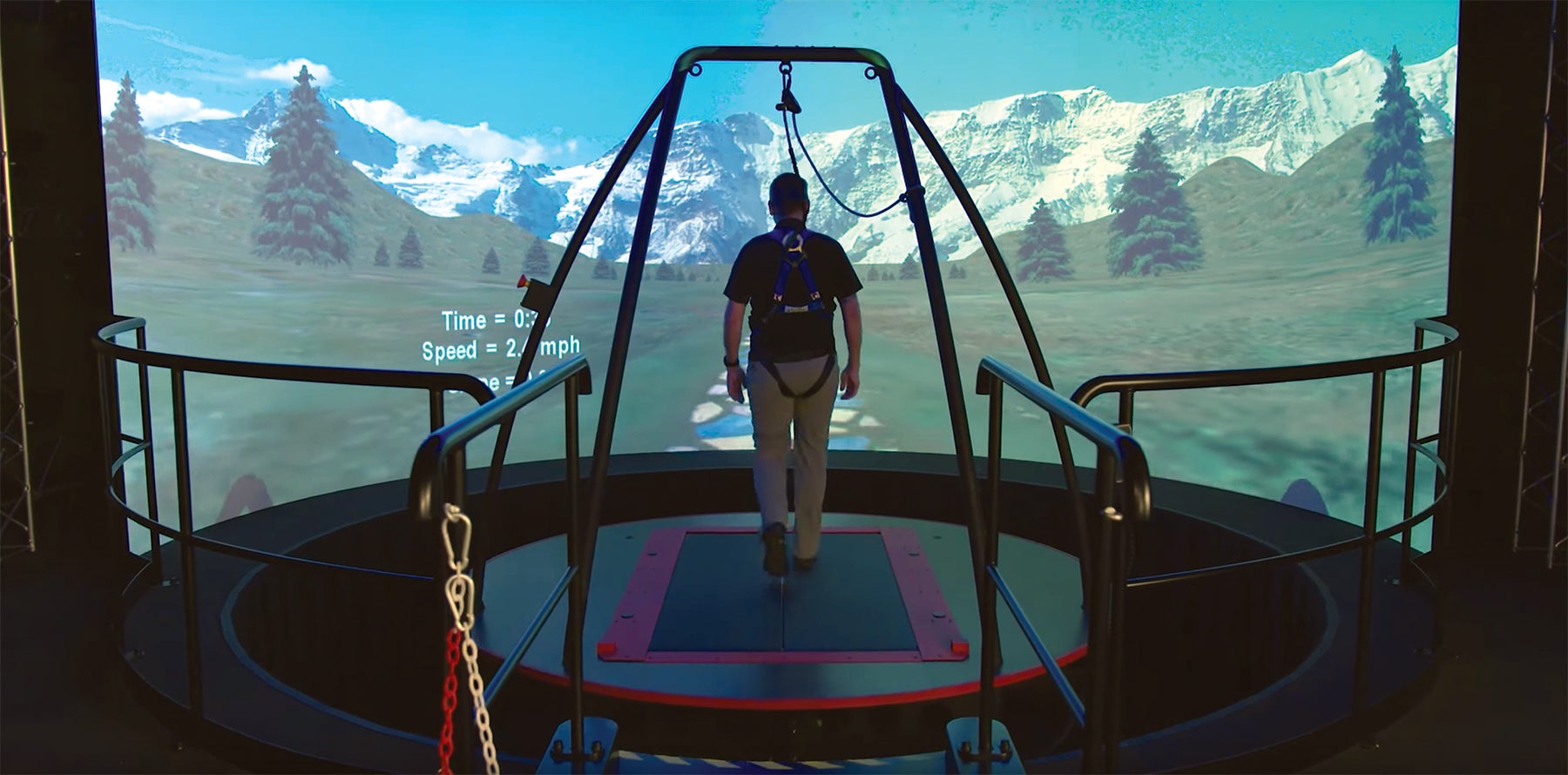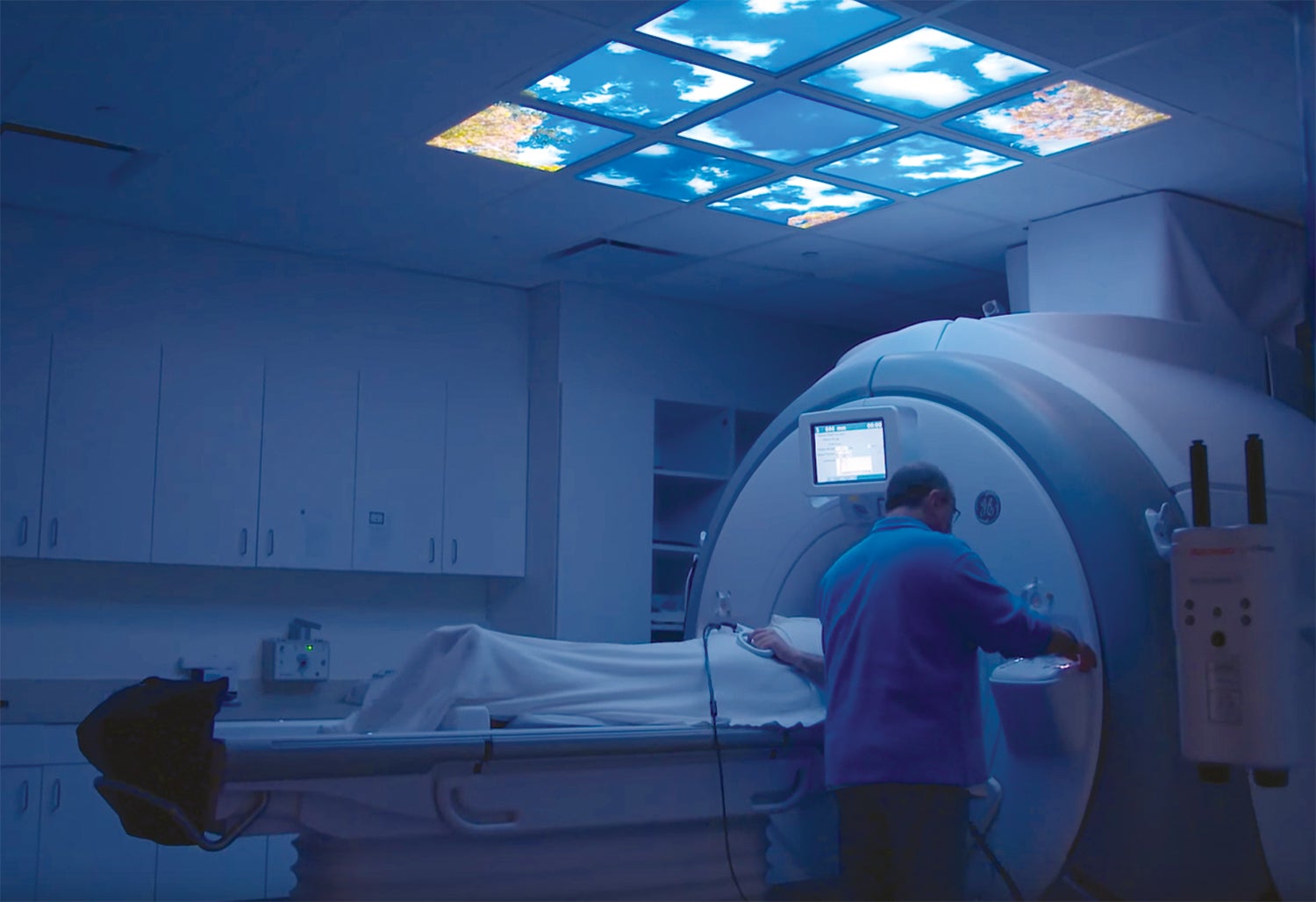When Sgt. 1st Class Victor Medina received groundbreaking therapy in 2012 involving virtual reality and computer-generated puzzles to help recover from a brain injury sustained in Iraq, he wasn’t thinking about the future of the Army. As one of the first patients at the National Intrepid Center of Excellence in Bethesda, Md., Medina needed help to improve cognitive function, including memory, focus, reaction time and speech.
At the time, such problem-solving and stimulation therapy was used to treat injuries, learning disabilities and behavioral disorders and was considered a possible treatment for those suffering from dementia and Alzheimer’s.
But those therapies also had implications for future warfighters, as researchers were beginning to probe whether the treatments could make current and future soldiers faster, smarter and maybe even stronger.
When Medina started treatment, he couldn’t walk, talk or speak. He credits brain training with helping him recover sufficiently to return to school and earn a master’s degree.
“It was key to rewiring my brain, and I think it gave me the strength to prevent post-traumatic stress disorder,” said Medina, now retired.
Expand Your Mind
Over the past five years, neuroscientists have made significant strides in understanding the brain’s structure, plasticity, abilities and potential. They are exploring how to use technologies like brain exercises, advanced imaging, sensors, nanotechnology, gene editing and artificial intelligence to enhance cognition and expand soldiers’ minds.
The Army has even established the Mad Scientist Initiative to bring together military and federal researchers, academicians and industry to explore options for building a “supersoldier.”
“Not much has changed in the soldier physiologically … from World War I, World War II,” said Luke Shabro, deputy director of the initiative at the U.S. Army Training and Doctrine Command. “Short of being larger and potentially healthier, the human body itself hasn’t changed much. Those limitations, however, may change over the next 30 years.”
A large part of this warfighter enhancement effort is focused on the brain. Proponents say cognitive enhancement could be key to ensuring soldiers are physiologically equipped for the adversary of 2050.
“There is an enormous amount of cognitive training that can be done, tapping into the networks of the brain that can be improved, like visual processing, memory and other things, even dramatic improvements,” said Amy Kruse, a former Defense Advanced Research Projects Agency (DARPA) project manager and chief scientific officer at the Platypus Institute, an organization that studies technology to enhance human performance. “The mind and the body are quite connected.”
While it sounds like science fiction, some of these technologies are already available, with troops learning to focus and learn skills faster. And federal entities are working across government, academia and industry to quickly expand the options.
Soldiers currently can boost their brainpower by logging onto Army Knowledge Online and using BrainHQ, a training program developed by the firm Posit Science that targets attention span and processing speed. The idea behind the exercises is to bolster basic cognitive foundations to support advanced function such as memory and decision-making.
Some brain-training companies have come under fire for making false claims, and studies have been mixed on the exercises’ effectiveness, but Posit Science’s proven track record with troops and veterans suffering cognitive impairment led DoD early this year to make BrainHQ available to every soldier, sailor, airman and Marine. Dependents also can access it through Military OneSource and base libraries.
“BrainHQ has the best science I have seen” of brain-training programs, said Kruse, who is not affiliated with Posit. “It is absolutely beneficial. It’s not the most exciting, the graphics aren’t the best ... but still, what they have is scientifically validated.”
“The evidence keeps growing every month,” Posit Science CEO Henry Mahncke said in a news release. “Of course, if you have a brain that operates more quickly and accurately, that should impact nearly every waking moment of your life.”
In testing at the U.S. Army Natick Soldier Research, Development and Engineering Center, Mass., scientists explore potential benefits of neurostimulation—activating portions of the brain through invasive or noninvasive means using low-intensity electrical current to accelerate learning.
In one study at the Center for Applied Brain and Cognitive Sciences in Medford, Mass., volunteers wore caps that provided electrical stimulation during virtual reality training. Participants saw their attention span increase on mundane tasks such as monitoring security screens from 20 minutes up to 20 hours, and they improved their ability to recognize faces and navigate urban battlefield simulations.
Rigorous Science Required
“We’ve seen a lot of positive effects of neurostimulation in our lab,” Natick senior cognitive scientist Tad Brunye said. “Soldiers are willing to try just about anything to enhance their mental and physical performance. … But we need to be sure that any commercial claims are supported by rigorous experimental science and that the systems are being used only in appropriate and beneficial ways.”
The U.S. Special Operations Command also has been testing neurostimulation to improve motor skills and learning. Through the Defense Innovation Unit Experimental, troops have worn a headphone-style device that the maker, Halo Neuroscience, describes as “neuropriming.” It is meant to stimulate the brain to become hyper-receptive, allowing for faster and improved learning.
In one case study of CrossFit athletes in San Diego, top performers increased their average weight-training load by 5 percent, according to the company. “Five percent may not seem like a lot to casual athletes, but single-digit improvements break records in CrossFit,” the company said, adding the same would hold true for elite warfighters.
For years, DARPA researchers have explored the depths of the brain. In 2013, the agency launched a program exploring how to restore memory function in ill or injured troops. More recently, the Targeted Neuroplasticity Training program is designed to explore the brain’s ability to learn information.
The Natural Approach
By activating natural neural chemicals, scientists hope to make the brain more adaptive; facilitating learning and long-term retention on subjects that take months or years to master, such as foreign language and cryptography.
“DARPA is approaching the study of synaptic plasticity from multiple angles to determine whether there are safe and responsible ways to enhance learning and accelerate training for skills relevant to national security missions,” former program manager Doug Weber said a year into the program. “DARPA’s goal with [Targeted Neuroplasticity Training] is to further enhance the most effective existing training methods so the men and women of our armed forces can operate at their full potential.”
Also at DARPA, Kruse demonstrated that something as simple as neurofeedback can help improve training. Strapping sensors onto the heads of snipers working in a virtual reality setting, Kruse mapped a “brain state” these experts reach before they take a difficult shot. By placing simple sensor caps on novice shooters, Kruse could teach the newcomers to enter a similar state of mind before shooting. The results? They improved their skills an average 100 percent.
“Just that little bit of extra feedback in the brain gave them the opportunity to know what it felt like and allowed them to get into that state,” Kruse said.
Diet, Drugs and Behavior Modification
Troops turn to caffeine and energy drinks to enhance performance. Pilots use prescription medications like modafinil to remain focused and maintain alertness. And about 70 percent of U.S. service members report taking at least one dietary supplement, according to the Pew Charitable Trusts.
With service members already looking to improve their physiology, DoD has an obligation to study nutritional supplements, medications and other low-tech approaches to performance enhancement, argued Andrew Herr, adjunct fellow at the Center for a New American Security and chief executive officer at Helicase, a company that designs tailored programs for individuals and teams seeking to improve performance.
“Nutrition, supplements, meditation, sleep, medical interventions and nonmedical drug interventions are effective. … No drugs, no hormones or anything, all things that can be implemented today with even bare-bones capability,” Herr said.
In a study conducted on Army ROTC cadets of a proprietary blend of nine dietary supplements, participants’ overall mood improved by 55 percent, sleep improved by 25 percent and they cut an average 30 seconds off their 2-mile run times. “We can make very large improvements in things people care about very quickly,” Herr said.
The services have a long history of studying nutrition and supplements for boosting performance and mental health. In the past few years, zinc and omega-3 fatty acids have taken center stage in research on preventing concussion. More recently, Special Operations Command has looked at performance enhancers and supplements to improve focus and stamina in special operations troops.
The Future
At a March conference hosted by Training and Doctrine Command and SRI International on bioconvergence (the melding of technologies with biology and medicine to enhance capabilities), researchers focused on what Kruse called Warfighter 2.0, how to upgrade human performance by enhancing cognitive and physical abilities.
Already, researchers and amateur scientists worldwide are exploring the integration of artificial intelligence with the human body, editing their genes, “bio-hacking” their bodies with medicines or devices to boost performance, and using nanotechnology to monitor one’s health.
Some of these alterations are lower-tech—inserting a chip under one’s skin, for example, to access locked spaces or computers—while others push the edges of scientific development. Clustered Regularly Interspaced Short Palindromic Repeats (CRISPR) is one of these advancements, used to optimize gene editing. According to a report earlier this year, Chinese doctors have edited the genetic profiles of 86 patients to treat late-stage cancer, HIV or other diseases. Researchers extracted immune cells from ill patients and using CRISPR technology, edited them and transfused them back into the patients’ bodies.
China also is making advancements in brain/computer interfaces, designing brain-controlled robots and attempting to create a “battle brain,” a network of individual brains working on a collective task, according to Elsa Kania, an adjunct fellow at the Center for a New American Security.
Do-it-yourselfers also lead the science. At a computer-hacking conference last summer in Las Vegas, more than 40 percent of attendees in the convention’s “biohacking village” had some type of implant—magnets, chips or other sensors—in their bodies. “We have always thought of ways of improving people by giving them another tool. The question is now, should we be thinking about upgrading the human, giving them a bigger capacity for sensation, memory or something, and what might that look like?” Kruse said.
Ethical Concerns
Not surprisingly, the idea of enhancing a human raises ethical concerns. In the military, this goes beyond questions of human identity. DoD must consider safety and deployment of technologies, who would be eligible, whether they should be reversible, even whether such upgrades make a soldier a weapon under the Geneva Conventions or turn them into biological weapons.
In the 2013 report, “Enhanced Warfighters: Risk, Ethics, and Policy,” Cal Poly San Luis Obispo professor Patrick Lin and others raised concerns about the operational, ethical and legal implications of enhancing warfighters. “Besides the obvious issue of free and informed consent of the test subject, there may be issues about the wider effects of an enhancement. … These are open-ended questions we don’t have a policy for yet. The technology is starting to outpace the policy and it becomes increasingly difficult to legislate these things,” Lin said in an interview.
He advocated considering ethical issues now, before the technology has been achieved or mastered.
On the other hand, Herr argued, DoD may have an obligation to research and deploy human performance-enhancement technologies to save soldiers’ lives. “Have you seen what their jobs are? We are asking them to jump out of planes in training and people get hurt. We may be ethically obligated to provide them performance-enhancement opportunities, provided they choose and it’s not mandatory. Let’s get past this cutesy ‘someone might get a little sick’ fear in research.”
With China doing research in a field many Americans find morally reprehensible—gene editing—some advocates say the U.S. must pursue similar research to ensure battlefield parity. Lin called that argument “effective,” but said it is a “dim, short-sighted view on the value of ethics, human rights and the U.S. Constitution.”
“If keeping up with our adversaries means losing our national soul, then what exactly are we fighting for?” he asked.




